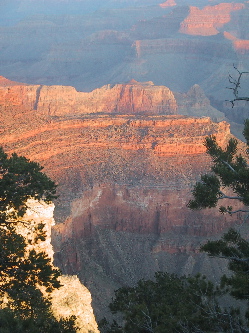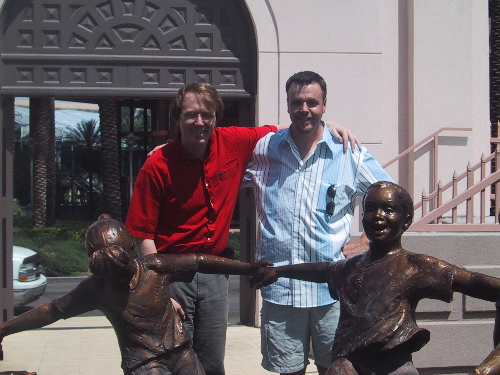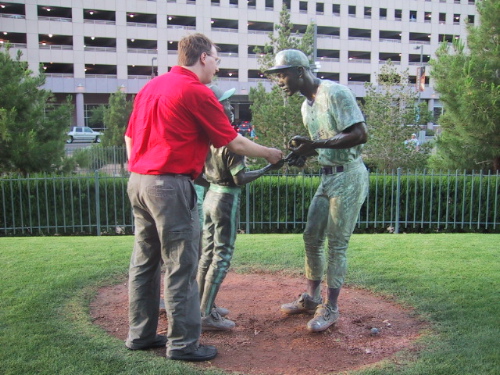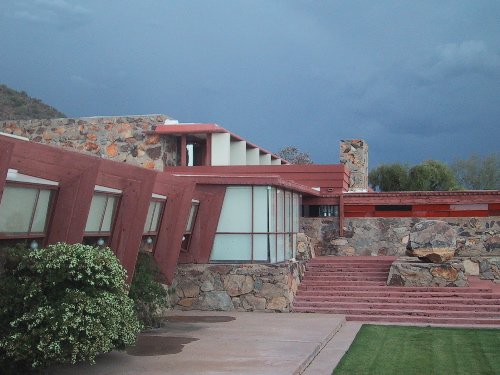I’ve written here before about Martin Rutte, consultant, author, husband of Islander Maida Rogerson, and resident of Santa Fe, New Mexico. When I knew that Mike and I would be passing through the Santa Fe today, I emailed Martin and asked him what we should be sure not to miss. Among his recommendations was a tea house called Maison & Tea, on the art gallery-drenched Canyon Road downtown. It was a good recommendation: a beautiful, open space with truly outstanding staff and a jasmine tea the drinking of which rendered me feeling like I’d been pleasantly hit with a gelatinous brick. The owner, who I met briefly, has plans to show black and white movies outside on the patio, projected against the adobe walls, come summer. Cool.
Our introduction to Santa Fe was rather more Scarboroughesque: the unfortunately traditional miles-long strip with multiple Burger Kings, a mall or two, a power center with the usual big boxes, and innumerable auto dealers. We stayed at a Fairfield Inns halfway up the strip from I-25, which was as you might expect (but for a fantastic innovation in the breakfast room: make your own waffles).
Much of our morning was occupied with various car-related matters, the centerpiece of which was four new hub-caps for Mike’s VW Golf for $24.99 from Pep Boys. The car looks 100% better.
Next we headed into the downtown plaza of the city, which reminded me of many of the towns and villages I visited around El Paso a decade ago: a central open plaza surrounded by low-slung adobe buildings. We had fresh, tasty fajitas from a street vendor, toured many shops and a couple of museums, had a great visit at a store that sells Zuni fetishes, a great lunch at the O’Keeffe Cafe (beside the Georgia O’Keeffe Museum), a blasty tonic at the Longevity Cafe, and then headed north towards Denver.
After the rugged and somewhat mountainous terrain through Hopi and Navajo territory on the way through Arizona and New Mexico towards Santa Fe, we were surprised to, thwack, hit a dead-flat desert from Santa Fe up to the Colorado border. At Raton, NM, this all changed as we headed over the Raton Pass, 1000 feet up, to enter Colorado.
Our dinner, at the Trinidad Diner, up the highway in the small town of Trinidad, almost completely erased the food halo that surrounded us in Santa Fe: the menu consisted almost exclusively of various fried items combined with various other fried items. Mike opted for the “healthy” turkey on a croissant, which turned out to be turkey, bacon, cheese and tomatoes lathered onto a soggy croissant. He might as well have deep fried his head. I didn’t do much better with a hamburger and pencil eraser-like french fries. The iced tea, however, was excellent. The Conoco gas station across the street where I stopped to try and find some sort of purgative tonic to help me get over this meal was, alas, also a Churches Fried Chicken outlet, so the smell of deep fried gack filled its air as well. Needless to say, we high-tailed it out of Trinidad.
As I type, I’m sitting in a Hampton Inns property about 13 miles south of Denver. We’ve got a full day in Denver tomorrow before I fly JetBlue to Boston overnight. Expect muddled grumpiness on Thursday.
 Sunday morning Mike and I drove up Rte. 180 to the south rim of the Grand Canyon. This is our story.
Sunday morning Mike and I drove up Rte. 180 to the south rim of the Grand Canyon. This is our story.
We managed to snag last minute reservations for a room within the Grand Canyon National Park at Maswik Lodge, which turned out to be a basic but serviceable room about 1/4 mile from the rim. Our room was available for us when we arrived about 1:00 p.m., so we unloaded our gear, and prepared to experience the wonders of the Canyon.
At Mike’s insistence, we caught the Park shuttle bus to the very last stop, Yaki Point. As such, we managed to delay actually seeing the Canyon for another 30 minutes. It was worth it, though. It’s difficult to do justice to the Grand Canyon in words, mostly because it’s such an overwhelming experience, that it’s hard to even comprehend myself. After 24 hours of various views into the Canyon, I felt like the volume in my visual life was turned up to “10” and, to be honest, longed for a simple, human scale view of a plain old northeastern town. I’m not complaining, simply describing something that could be best described as “awesomeness fatigue.”
Over the afternoon we wended our way west along the Canyon rim. We both remarked at how non-commercialized the Park was, and how fear of litigation didn’t seem to have effected the Park planners, as there were no large fences — or really anything — separating visitors from the edge of the Canyon (which may explain why Over the Edge: Death in Grand Canyon was tagged “Our Best Seller!” in the hotel gift shop).
We had a fantastic dinner on the Canyon edge, and retired early to bed so as to be able to get up at sunrise (aided somewhat by a bottle of red wine which appeared to double its usual effects at the high elevation). Note to self: in future, do not walk near the Canyon wall after drinking half a bottle of wine.
This morning, mostly due to Mike’s energy and urging, and despite a freak occurrence of Piano Man by Billy Joel played on a car stereo at incredible volume at 1:30 a.m. in the hotel parking lot, we rose at 5:30 a.m. and hurried to Yavapai Observation Station to watch the sun rise. I took a whole host of photos, and was amazed at the different quality of the Canyon at that hour, with the angle of the sun making all of the reds redder and the oranges oranger. It was truly an amazing site, and if you visit Grand Canyon, your visit will not be complete unless you follow suit.
After some recovery time, and a breakfast (in the surprisingly complete, inexpensive, and spacious cafeteria at Maswik Lodge), we got in the car and headed east towards Santa Fe.
We decided to take the somewhat longer route along Rte. 64 to Desert View, then through Cameron, Tuba City, down through Hopi and Navajo country, and up through Albuquerque. While it was a long day of driving, the scenery was stellar — everything from flat, endless dessert to towering mountains and red cliffs. We arrived here in Santa Fe around 10:30 p.m., and will be around and about this city tomorrow. Mike is daunted by the prospect of re-encountering snow in Denver, where it has been snowing this week, so we might hang here longer, and breeze up to Denver on Wednesday.
Time to sleep; looking forward to ambling around Santa Fe tomorrow, with the volume turned down to 3 or 4 for a chance.
Gotta be quick, as brother Mike, impatient with technology, glowers. Flew to Phoenix on Friday and hooked up with Mike near the airport. Saturday we went downtown to a great barber (from Ohio) and got our hair cut. Then up to Taliesin West for the afternoon (amazing). Back into Phoenix for an Arizona Diamondbacks home game, then a late night drive north to Flagstaff where we stayed at the Weatherford Hotel, which was a terrific antidote to the generic hotels I’d been staying in for a week (even if it did mean a train rumbling my every hour or so).
The weather here is amazing: there is a world’s worth of weather packed into Arizona. 85 degrees yesterday in Phoenix; in the mid-40s here in Flagstaff this morning. We’re about to head up Rte. 180 to the Grand Canyon, and were asked if we have “any experience with driving in snow and ice.”
Staying inside Grand Canyon National Park tonight; touring the Canyon tomorrow.
Glowering has turned to impatient stubborn looks, so I must sign off.
Regular readers may recall the story of my lime green cardigan, the cardigan that has been blessed by Most Rev. Bishop Fougere and lauded by Ian Williams.
Today, by random chance, it appears that said cardigan has achieved relevance again: Americans, it seems from the evidence on the ground here in Dublin, NH, wear lime green clothes on Good Friday in some sort of complicated Easter color scheme.
I believe that this random act of sartorial happenstance may be enough to recover me from the social purgatory I have mired in since St. Patrick’s Day, 1997, when I mistakenly wore my bright orange winter coat to the post office.
I’ve only been at the Jack Daniels for 3 days now, and I’ve already settled into a routine.
Every night at 11:00 p.m. I watch The West Wing re-runs on Bravo (which, by the way, is a much less Anton Kuerti-focused channel here in America). Then I go to sleep.
The alarm goes off at 7:30 a.m., and I turn on the TV to a station that plays the modern I’ve Got a Secret until 8:00 a.m. Today’s guest was Charro, who, believe it or not, is much as she was in the 1970s; her secret was that she speaks fluent Japanese (in addition to 4 other languages). Who knew? The panelists this week have been Terri Garr, that annoying campy guy who played the “ambiguously gay neighbour” on several sitcoms in the 70s and 80s, that guy who played the district attorney several seasons ago on The Practice and a fourth I can’t recall. As my friend Sherin remarked today: without The Love Boat and Murder, She Wrote, cable game shows like this are the only refuge for the once-a-B-list crowd.
I’ve benefitted from several lavish spreads at Yankee this week: on Tuesday there was a breakfast potluck to celebrate the on-sale date of the 2004 edition of the Yankee Magazine Travel Guide to New England (which is actually quite a useful tool for planning a New England vacation). Today there was an afternoon tea (complete with linen and china!) to celebrate the move of the magazine’s distribution to a new fulfilment house (complete with all the data conversion you might imagine that entails). In other words, I’m eating like a king.
Tomorrow I break the routine to fly out to Phoenix to hook up with Brother Mike who, word has it, is burning up the mid- and south-west U.S. with his blockbuster vacation. It will be hard for me to keep up.
Gotta run: West Wing starts in 40 minutes!
Fence fines could come this summer, reports the CBC:
… farmers who don’t comply could face fines of up to $300,000.
I’m all for keeping cattle out of streams. I would also go to the barricades to support any farm family that was fined the crazy amount of $300,000 for violating cattle-in-streams rules.
Doesn’t it strike anyone that $300,000 is an absurd amount, so absurd, indeed, as to make it ineffective as a deterrent?
For the cattle operations I know, $300,000 isn’t a “slap on the wrist” or a “woah, we’ll never do that again,” it’s a “shut down the business and be in debt for the rest of our lives.”
There’s an amount for fines that says clearly “this is a serious problem and you need to pay attention.” Then there’s an amount like this that says “that is so crazy that they can’t possibly mean it.”
I have been getting money from the ATM at the Dublin General Store for almost 10 years. Yesterday I went down the hill to the store for lunch, took my ATM card out of its wallet, went to stick it into the machine. And the machine wasn’t there.
The store is undergoing spring renovations, and part of this is a new, smaller, private-label ATM machine inside the store, which replaces the old outdoor Granite Bank model out on the porch.
I’m not sure I’m reacting well to this change.
I did have a very nice short stack of blueberry pancakes this morning, and I went all out and upped for the “pure” maple syrup, which costs an extra $1.25 more than the “generic” maple syrup. Was there ever any question?
The Jack Daniels Motor Inn, where I’m staying this week, is under new management. The most obvious evidence is that they now have 79 channels on the cable TV, and they offer a free sample of Tom’s of Maine toothpaste to all guests. Otherwise, alas, the place still feels like it was constructed as a temporary shelter for the road crew 15 years ago.
It’s chilly here, but in a spring kind of way.



 I am
I am